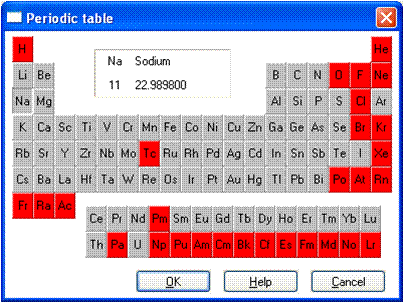
The MRL has a wonderful Inductively Coupled Plasma (ICP) Atomic Emission Spectrometer that is available for use on a recharge basis. Our Instrument is a Thermo iCAP 6300 model that can simultaneously view emissions from as many elements and lines as desired. It is easy to use and offers high sensitivity measurements of aqueous solutions from 10 PPB to over 250 PPM. The optimum working range for element concentrations is from 50 PPB to 100 PPM by weight.
The ICP uses a very hot argon plasma to excite atoms into high energy states. As these atoms relax they emit light at characteristic wavelengths, or lines. The ICP can measure about 70 elements in aqueous solutions, including most metals.
The ICP can measure any number of elements at a time. It can measure every element on the Periodic Table shown in grey below except Argon and Nitrogen. Cesium can only be done at relatively high concentrations.

Determinations down to 10 PPB or less are possible for many elements in clean solutions. Measurements of element concentrations over 100 PPM are routine. All sample solutions must be absolutely free of particulates, sediments, precipitates, suspended gels, or lipids.
The ICP is usually used for the quantitative measurement of the concentration of elements in solution. But the ICP can also be used to find out what elements are present in a sample. Samples for quantitative measurements are compared to standard solutions. Users bring their own calibration standards.
The ICP only takes 3 to 4 minutes to measure each sample, but it requires almost an hour to warm it up, standardize, and rinse after use.
More Information
Inductively Coupled Plasma-Atomic Emission Spectroscopy (294Kb): A good introductory Paper by Thomas Manning & William Grow. This is available for download in Adobe Acrobat format. To view it you will need Adobe Acrobat Reader, which can be downloaded here.
Sample Requirements & Standards
All of the standards and unknowns used on the ICP Spectrometer should be clear, homogeneous, and aqueous. Many problems can be avoided if the samples are sufficiently diluted to be below 250 PPM for each element of interest and if the total dissolved solids do not exceed 1%. Likewise, samples and standards must be free of all particles, precipitates, and sediments.
Most tests require about 10 to 15 mls of solution. With care tests can be done with 4 ml or less. Since solutions are usually dilute, most users prefer to bring an excess of sample.
The sample introduction system on our instrument is designed to allow the use of sample solutions with strong acids, including HF. Samples containing organic solvents cannot be run on this instrument.
Getting Trained to use the ICP at the MRL
We offer the ICP Training Course once per quarter. If you would like to attend a training session please let us know by e-mailing amanda [at] mrl [dot] ucsb [dot] edu (Amanda Strom).
Default Operating Conditions:
Sample Uptake Rate: 1.5 mL/min
Carrier Gas Flow: 0.5 L/min
Nebulizer: Burgener Teflon Mira Mist, inert PTFE with hyrdrophillic coating
Torch: Radial view, viewing height 13 mm, RF power 1150 W
Lab:
Contact:
If you have additional questions after you have checked out the information at the above links, please feel free to e-mail questions to amanda [at] mrl [dot] ucsb [dot] edu (Amanda Strom).
